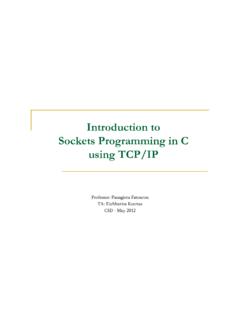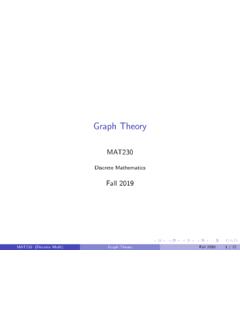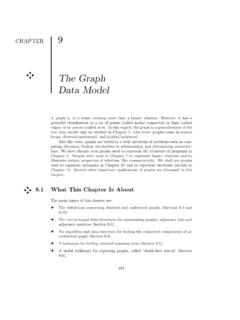Transcription of Chapter 10
1 Chapter 10 The Traveling Salesman Problem Introduction The traveling salesman problem consists of a salesman and a set of cities. The salesman has to visit each one of the cities starting from a certain one ( the hometown) and returning to the same city. The challenge of the problem is that the traveling salesman wants to minimize the total length of the trip. The traveling salesman problem can be described as follows: TSP = {(G, f, t): G = (V, E) a complete graph, f is a function V V Z, t Z, G is a graph that contains a traveling salesman tour with cost that does not exceed t}. Example: Consider the following set of cities: 5 12 2 3 10 8 4 3 AEB DC Figure A graph with weights on its edges.
2 The problem lies in finding a minimal path passing from all vertices once. For example the path Path1 {A, B, C, D, E, A} and the path Path2 {A, B, C, E, D, A} pass all the vertices but Path1 has a total length of 24 and Path2 has a total length of 31. Definition: A Hamiltonian cycle is a cycle in a graph passing through all the vertices once. Example: AEB DC Figure A graph with various Hamiltonian paths. P = {A, B, C, D, E} is a Hamiltonian cycle. The problem of finding a Hamiltonian cycle in a graph is NP-complete. Theorem : The traveling salesman problem is NP-complete. Proof: First, we have to prove that TSP belongs to NP. If we want to check a tour for credibility, we check that the tour contains each vertex once. Then we sum the total cost of the edges and finally we check if the cost is minimum.
3 This can be completed in polynomial time thus TSP belongs to NP. Secondly we prove that TSP is NP-hard. One way to prove this is to show that Hamiltonian cycle TSP (given that the Hamiltonian cycle problem is NP-complete). Assume G = (V, E) to be an instance of Hamiltonian cycle. An instance of TSP is then constructed. We create the complete graph = (V, P G E ), where E = {(i, j):i, j V and i j. Thus, the cost function is defined as: t(i ,,j ) = . j) (i, if 1, j) (i, if 0EE Now suppose that a Hamiltonian cycle h exists in G. It is clear that the cost of each edge in h is 0 in Gas each edge belongs to E. Therefore, h has a cost of 0 in G . Thus, if graph G has a Hamiltonian cycle then graph G has a tour of 0 cost.}
4 Conversely, we assume that G has a tour h of cost at most 0. The cost of edges in E are 0 and 1 by definition. So each edge must have a cost of 0 as the cost of h is 0. We conclude that h contains only edges in E. So we have proven that G has a Hamiltonian cycle if and only if G has a tour of cost at most 0. Thus TSP is NP-complete. Methods to solve the traveling salesman problem Using the triangle inequality to solve the traveling salesman problem Definition: If for the set of vertices a, b, c V, it is true that t (a, c) t(a, b) + t(b, c) where t is the cost function, we say that t satisfies the triangle inequality. First, we create a minimum spanning tree the weight of which is a lower bound on the cost of an optimal traveling salesman tour.
5 Using this minimum spanning tree we will create a tour the cost of which is at most 2 times the weight of the spanning tree. We present the algorithm that performs these computations using the MST-Prim algorithm. Approximation-TSP Input: A complete graph G (V, E) Output: A Hamiltonian cycle a root vertex r V [G]. MST-Prim (G, c, r) to compute a minimum spanning tree from r. L to be the sequence of vertices visited in a preorder tree walk of T. the Hamiltonian cycle H that visits the vertices in the order L. The next set of figures show the working of the proposed algorithm. A B E C (a) (b) (c) DAB DCAB DEC EFigure A set of cities and the resulting connection after the MST-Prim algorithm has been In Figure (a) a set of vertices is shown.
6 Part (b) illustrates the result of the MST-Prim thus the minimum spanning tree MST-Prim constructs. The vertices are visited like {A, B, C, D, E, A) by a preorder walk. Part (c) shows the tour, which is returned by the complete algorithm. Theorem : Approximation-TSP is a 2-approximation algorithm with polynomial cost for the traveling salesman problem given the triangle inequality. Proof: Approximation-TSP costs polynomial time as was shown before. Assume H* to be an optimal tour for a set of vertices. A spanning tree is constructed by deleting edges from a tour. Thus, an optimal tour has more weight than the minimum- spanning tree, which means that the weight of the minimum spanning tree forms a lower bound on the weight of an optimal tour.}
7 C(t) c(H*). Let a full walk of T be the complete list of vertices when they are visited regardless if they are visited for the first time or not. The full walk is W. In our example: W = A, B, C, B, D, B, E, B, A,. The full walk crosses each edge exactly twice. Thus, we can write: c(W) = 2c(T). From equations and we can write that c(W) 2c(H*), Which means that the cost of the full path is at most 2 time worse than the cost of an optimal tour.
8 The full path visits some of the vertices twice which means it is not a tour. We can now use the triangle inequality to erase some visits without increasing the cost. The fact we are going to use is that if a vertex a is deleted from the full path if it lies between two visits to b and c the result suggests going from b to c directly. In our example we are left with the tour: A, B, C, D, E, A. This tour is the same as the one we get by a preorder walk. Considering this preorder walk let H be a cycle deriving from this walk. Each vertex is visited once so it is a Hamiltonian cycle. We have derived H deleting edges from the full walk so we can write: c(H) c(W) From and we can imply: c(H) 2 c(H*).
9 This last inequality completes the proof. The general traveling salesman problem Definition: If an NP-complete problem can be solved in polynomial time then P = NP, else P NP. Definition: An algorithm for a given problem has an approximation ratio of (n) if the cost of the S solution the algorithm provides is within a factor of (n) of the optimal S* cost (the cost of the optimal solution). We write: max( S/S*, S*/S) (n). If the cost function t does not satisfy the triangle inequality then polynomial time is not enough to find acceptable approximation tours unless P = NP.
10 Theorem : If P NP then there is no approximation algorithm with polynomial cost and with approximation ratio of for any 1 for the traveling salesman problem. Proof: Let us suppose that there is an approximation algorithm A with polynomial cost for some number 1 with approximation ratio . Let us assume that is an integer without loss of generality. We are going to try to use A to solve Hamiltonian cycle problems. If we can solve such NP-complete problems then P = NP. Let us assume a Hamiltonian-cycle problem G = (V, E). We are going to use algorithm A to determine whether A contains Hamiltonian cycles. Assume G = (V,E ) to be the complete graph on V. Thus: E = {(a, b): a, b V and a b} Each edge in E is assigned an integer: t(a, b) = + elseVpE1||, b) (a, if 1 Consider the traveling salesman problem (G , t).










